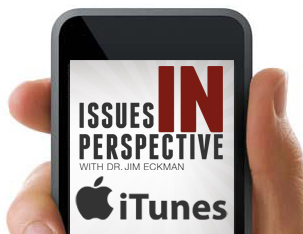Anger Fear Or Revival?
Jun 7th, 2025 | By Dr. Jim Eckman | Category: Culture & Wordview, Featured IssuesThe mission of Issues in Perspective is to provide thoughtful, historical and biblically-centered perspectives on current ethical and cultural issues.

Traditional religion in the United States has suffered huge losses in recent decades. The number of Americans identifying as “not religious” has increased remarkably. Religious affiliation, service attendance, and belief in God have declined. More and more people claim to be “spiritual but not religious.” Religious organizations have been reeling from revelations of sexual and financial scandals and cover-ups. Public trust in “organized religion” has declined significantly. Crucially, these religious losses are concentrated among younger generations. This means that, barring unlikely religious revivals among youth, the losses will continue and accelerate in time, as less-religious younger Americans replace older more-religious ones and increasingly fewer American children are raised by religious parents.
Christian Smith, William R. Kenan, Jr. Professor of Sociology at the University of Notre Dame, has just published an important book, Why Religion Went Obsolete: The Demise of Traditional Faith in America. Drawing on survey data and hundreds of interviews, Christian Smith offers a sweeping, multifaceted account of why many Americans have lost faith in traditional religion. An array of large-scale social forces—everything from the end of the Cold War to the rise of the internet to shifting ideas about gender and sexuality-came together to render traditional religion culturally obsolete. For growing numbers of Americans, traditional religion no longer seems useful or relevant. “Using quantitative empirical measures of big-picture changes over time as well as exploring the larger cultural environment, Smith explains why this is the case and what it means for the future. Crucially, he argues, it does not mean a strictly secular future. Rather, Americans’ spiritual impulses are being channeled in new and interesting directions.”
I have great respect for Christian Smith and his marvelous work on culture, youth and faith. I have read most of the books he has written. His observations and analysis accurately capture the state of faith in America. I want to build on his conclusions and, in this Perspective, explore the state of faith in America, drawing on the work of evangelical Christian, columnist and attorney, David French, and columnist David Brooks, who recently converted to Christianity.
First, in a powerful article French published recently, he contrasts the two types of churches prevalent in America: The “fear-the-world” church and “the love-your-neighbor” church.
- “When I talk to Christians who are struggling with their faith, one of the first things I ask them is, ‘Were you raised in a fear-the-world church or a love-your-neighbor church?’ Most people instantly know what I’m talking about. The culture of the church of fear is unmistakable. You’re taught to view the secular world as fundamentally a threat. Secular friends are dangerous. Secular education is perilous. Secular ideas are bankrupt. And you’re always taught to prepare for the coming persecution, when ‘they’ are going to try to destroy the church . . . To be raised in a fear-the-world church is to experience a Christianity that declares with its words that the Resurrection is real, but seems incredulous about the possibility of a resurrection within its heart. If Christians truly can declare: ‘Where, death, is your victory? Where, death, is your sting?’ then why is there such pervasive fear?”
- “The love-your-neighbor church is fundamentally different. It’s so different that it can sometimes feel like a different faith entirely. The distinction begins with the initial posture toward the world—not as a threat to be engaged, but as a community that we should love and serve. Another way to describe a love-your-neighbor church is to say that it embraces a resurrection faith. Its aim is to follow Christ’s consistent pattern of moving to the suffering, the alienated and the sick, all to bring life from death. But a resurrection church that follows a resurrected savior should be a balm, not a blowtorch. It will never be perfect, of course, but its fundamental orientation isn’t toward protecting itself, but toward serving others. Its default posture toward difference isn’t suspicion, but affection. It’s easy to look at a politicized faith and despair. My church — the American evangelical church—is the pillar of Trump’s political strength. As countless Christians cheer, he’s wielding the weapons of government to hurt many of the most vulnerable people in the world. But there is another faith—one far removed from the headlines—that is doing something else entirely. Quietly and patiently, person by person, . . . This faith loves its enemies. It mends the broken heart. And it declares, by word and deed, that no one is too lost to experience the love of God.”
Second, Brooks writes of the “pagan” nature of current American culture, similar to “the pagan values of ancient Rome [that] celebrated power, manliness, conquest, ego, fame, competitiveness and prowess . . . Th[is] pagan culture is seductive because it lures you with images of heroism, might and glory. Think of Achilles slaughtering his enemies before the walls of Troy. For a certain sort of perpetual boy, what could be cooler than that? But there is little compassion in this worldview, no concept that humility might be a virtue. There is a callous tolerance of cruelty . . . The pagan ethos does not believe that every human was made in the image of God, does not believe in human equality, is not concerned about preserving the dignity of the poor. It does not care much about the universal feelings of benevolence, empathy and faithfulness toward one another, which, it turns out, are absolutely required for a democracy to function.”
- “Many great moral traditions have always stood against paganism and rebutted it. If paganism stands for manly dominance, Judaism, for example, stands for piety, learning and strictness of conscience. Think of the words so highly valued in Jewish life: chesed (loving kindness), simcha (joy, especially communal joy), anavah (humility), tzedek (justice and charity), limud (study and learning) and kedushah (holiness). Those words lift us up to an entirely different moral realm.”
- “For the Romans, the cross was a symbol of their power—their power to crucify. The early Christians took the cross as their symbol, too, but as a symbol for compassion, grace and self-sacrificial love. Christianity is built on a series of inversions that make paganism look pompous and soulless: Blessed are the meek. Blessed are the poor in spirit. The last shall be first. The poor are closer to God than the rich. Jesus was perpetually performing outrageous acts of radical generosity, without calculating the cost.”
Brooks concludes: “Judaism and Christianity confront paganism with rival visions of the good. The contrast could not be starker. Paganism says: Make yourself the center of the universe. Serve yourself and force others to serve you. The biblical metaphysic says: Serve others, and you will find joy. Serve God, and you will delight in his love.”
Although tentative, there are small signs of revival or at least an interest in spiritual things:
- There has been a relative surge in religious interest among young men. According to research by the evangelical Christian polling group Barna, 66 percent of Americans say they have made a personal commitment to Jesus—a 12-percentage-point jump since 2021.
- Similar things may be happening in Europe. In France the Catholic Church saw a 45 percent increase in new catechumens this Easter compared with last year, and it has baptized more than 17,000 people, the highest yearly number of entrants in over 20 years. According to an April report by the Bible Institute, the percentage of British adults age 18 to 24 who attend church at least monthly increased from 4 percent in 2018 to 16 percent today, including a 21 percent gain among young men. I’ve been predicting a revival among the religious left, but that seems not to be happening. The Christian resurgence in Britain is not among the progressive mainline denominations; it’s primarily among Catholics and Pentecostals, with two million more people attending church than six years ago.
“Are we on the cusp of a new religious revival?,” Brooks asks. The evidence is still much too flimsy and fresh to justify that kind of sweeping assertion. “But I do think we’re on the cusp of a great cultural transition. On the one hand, the eternal forces of dehumanization are blowing strong right now: concentrated power; authoritarianism; materialism; runaway technology; a presidential administration at war with the arts, universities and sciences; a president who guts Christianity while pretending to govern in its name. As the theologian Dallas Willard put it, there has been, over the past decades of neglect, a loss of moral knowledge.”
Therefore, in conclusion, I offer a few thoughts from a series of sermons I preached on the church. The term “world” in the Bible describes a world of evil, of adverse spiritual powers that work through humanity and aspects of God’s creation to produce hate, selfishness, greed, murder, violence and perversion. Satan, who rules this “world” (2 Corinthians 4:4), seeks to influence people in such a way that the true function of creation is brought to ruination. He distorts the structures of existence and seeks to hold people under the power of his perversion. Satan works through the structures of culture to distort, pervert, and disfigure that which is good. No part of the created order can escape the influence and power of Satan. This created order involves not only the physical realm of nature, but also the cultural institutions that regulate human existence: The state, economics, the family, ideas, social rules and regulations, and everything that orders human life and social institutions. The reality of satanic and demonic power is real and integral to biblical revelation.
The church is the New Covenant community of Jesus, indwelt by His Spirit, and empowered thereby to represent Him to the “world.” We represent Him with a certainty rooted in Christ’s finished work:
- Christ has bound Satan and all demonic powers. In Matthew 12:22-30, Jesus claims that He has entered into the domain of evil and found its source—Satan. It was in the temptations of Jesus (see Matthew 4) where Satan met his match. The Son of God, who came to enter the battle with Satan, seeks to destroy him (fulfilling Genesis 3:15). His success over Satan’s temptation demonstrates His power and His authority over Satan. He seeks to restore the wholeness of God’s creation that has been demented, twisted, distorted and corrupted by Satan. Hence the importance of Jesus’ healings, raising people from the dead, and of His death, burial and resurrection. He has triumphed over Satan in order to set creation free from the “bondage to decay” (see Romans 8:21). In a word, Jesus is eradicating evil in this world by becoming a victim of that evil, which in the end will mean its total and absolute destruction.
- Christ, through His death, burial and resurrection, has dethroned the power of Satan. In John 12:30-31, Jesus emphatically announced, “Now is the time for judgment on this world; now the prince of this world will be driven out.” In Colossians 2:15, Paul declared that through Christ’s death and resurrection, He “disarmed” the powers and authorities and “made a public spectacle of them, triumphing over them by the cross.” Christ has exposed Satan and his demonic powers for what they truly are. Thus, the church need no longer fear the tyranny of his falsehood, his deception or of his manipulation and control.
- When Christ returns, Satan’s influence over the world system will be utterly destroyed. Matthew 25:4 and Revelation 20:10 make clear that Satan and his minions will be forever cast into the lake of fire.
- Between Christ’s resurrection and Satan’s final defeat, his power is limited. But Satan is still the master of deception. He still blinds the eyes of people to the truth. He still masterminds faith in false gods and creates illusions for people to follow. But we must always remember the words of Jesus, “Take heart! I have overcome the world” (John 16:33). That is the central importance of the preaching and teaching of God’s Word. Through such preaching and teaching, Satan continues to be exposed to his defeat. Faith in Jesus Christ limits the extent of Satan’s activity. Preaching Christ unmasks the power of Satan, for that faith opens a person’s eyes to the deceptive nature of Satan and his power. Each time someone trusts Christ, the limitation on Satan’s power is exposed.
- Ephesians 1:9-10, Colossians 1:20 and 1 Corinthians 15:28 demonstrate that with the triumph of Jesus and the destruction of Satan comes the re-creation of the entire universe. This cosmic reconciliation will be completed when Christ returns, vanquishes His enemies and establishes His Father’s kingdom on earth.
Given these profound truths, what can we conclude?
- The church is the agent of God’s power in the world. The church is inextricably linked with the death, burial and resurrection of Christ, through which evil was defeated. Robert Webber writes: “This new view of life belongs to the church because Christ, the head of the church, is inseparably linked with it. His power over sin, death, and the dominion of the Devil now belongs to the church . . . The church acts in the name of Christ to witness through prayer, preaching, baptism, communion, lifestyle, and other means proclaiming that Satan is now doomed. The church is a corporate body of people who know Satan as a deceiver and liar. He has no ultimate power over them and their lives. Consequently, the church is a threat to Satan.” [The Church in the World, pp. 40-41] Satan truly hates the church and seeks to destroy it.
- Satan seeks to produce heresy in the church, discord in the church, to re-order the church’s priorities and to get the church to cultivate faith in power, in wealth and in human authorities, not in Christ. Anything that seeks to get the church off focus becomes a tool of Satan. For that reason, the church must be vigilant, on guard and dressed with the whole armor of God.
- The witness of the church in this age is to expose evil and to be the agent of reconciliation to God. That is the nature of the Gospel. That is the nature of being salt and light. We serve now because we will one day rule with Him; we serve now, rule later!
See David French in the New York Times (21 April 2025; David Brooks in the New York Times (2 May 2025).


